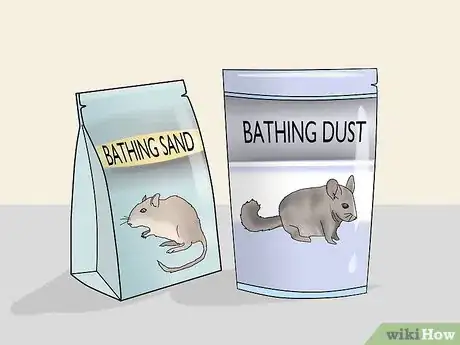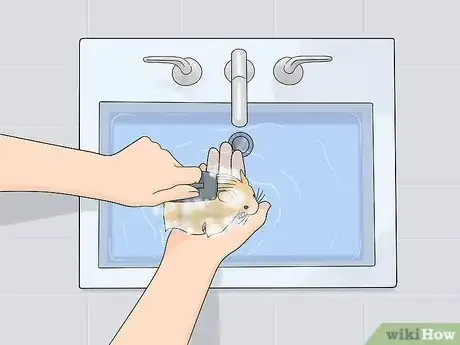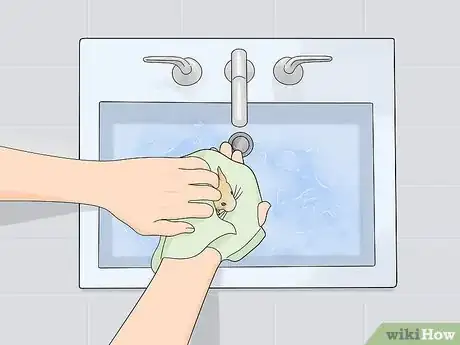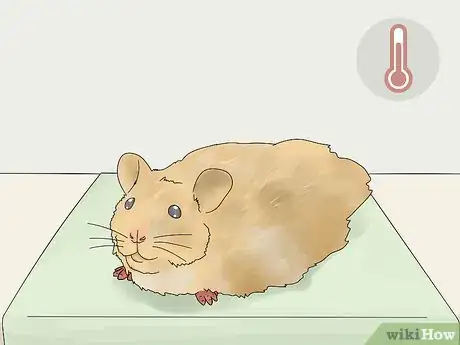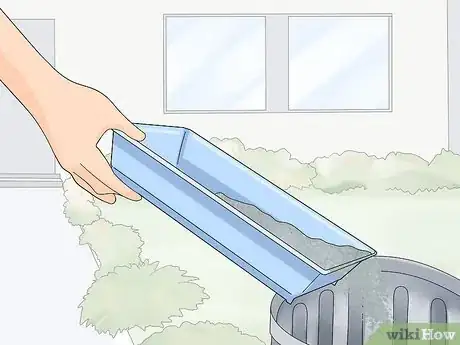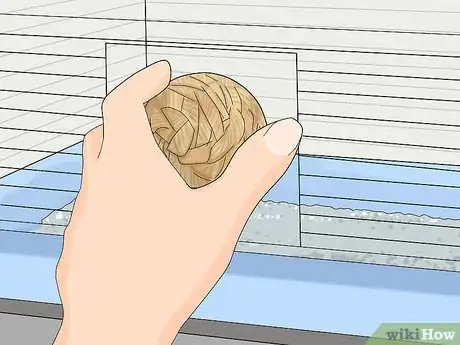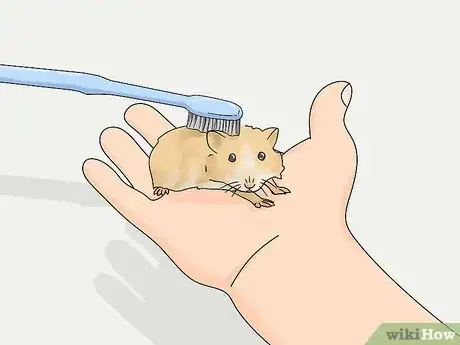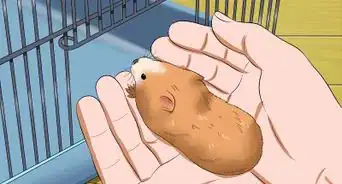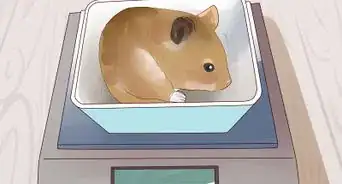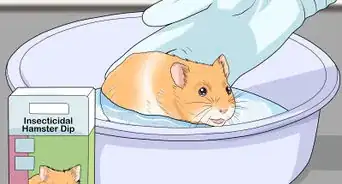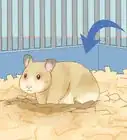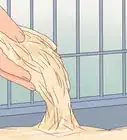This article was co-authored by Pippa Elliott, MRCVS. Dr. Elliott, BVMS, MRCVS is a veterinarian with over 30 years of experience in veterinary surgery and companion animal practice. She graduated from the University of Glasgow in 1987 with a degree in veterinary medicine and surgery. She has worked at the same animal clinic in her hometown for over 20 years.
This article has been viewed 24,271 times.
Hamsters make great pets, and are generally easy to take care of. Long-haired Syrians are a popular variety. However, the longer coat on these hamsters can require a bit more care when it comes to grooming.[1]
Steps
Taking Care of the Fur
-
1Set up a sand or dust bath. You can purchase dust powder or bathing sand from a pet store. These may be for rabbits or chinchillas, but can be used for the hamster.[2]
-
2Pour some of the sand or dust into a container. Pick a container that is made of ceramic, but is fairly shallow. These containers should not be easily overturned. Fill the container enough to allow the entire animal space to roll in it. Allow the hamster a few minutes to roll around in the sand.[3]Advertisement
-
3Brush the hamster. Use a soft brush or clean rag. Hold the hamster in one hand, or let a helper hold it. Gently clean off the hamster with the soft brush or rag.[4]
- Avoid the eyes, ears, and mouth. Use quick, light strokes.
-
4Remove the bathing dish. Clean the dish out thoroughly with water, and towel dry it to make sure it’s completely dry before a later use.[5]
- Use a fresh batch of dust or sand each time.
-
5Trim the fur. If brushing and bathing doesn’t improve your long haired hamster’s fur then you may resort to trimming. Avoid holding the hamster on its back while you do this. Keep it held in your hand or the hand of a helper. Use a small pair of scissors to trim just a little at a time from the matted fur.[6]
- Trimming may even be preferable to the hamster
- Feed the hamster a small piece of fruit or vegetable to keep it calm during the process.
Giving the Hamster a Wet Bath
-
1Try a wet bath if necessary. Get a shampoo specifically designed for hamsters or small pets from a pet store or pet aisle. Set some towels around to protect against splashing and make sure you’re in an area you don’t mind getting wet like a sink or basin.[7]
- This should ONLY be done if your hamster gets something toxic or harmful in it's fur. You should also try to cut or brush it out before resorting to use water. Bathing a hamster in water can strip it of it's natural oils.
-
2Shampoo and brush the hamster. Use a soft grooming brush. Hold the hamster in one hand, or let a helper hold them. Pour a little of the shampoo onto the brush with some warm water. Work it into the hamster’s fur with brief light stokes.[8]
- Avoid the eyes, mouth, and ears.
-
3Dry the hamster. Use a soft towel. You can cradle the hamster in the towel as long as the hamster has support, and feels safe. Make sure to gently pat down all of the hamster’s fur so it’s dry.[9]
-
4Put the hamster in a warm place. Check for drafts. You want to make sure the hamster is not exposed to any cold air vents, wind, fans, or anything else that might make it cold while wet. You need to leave it in this warm place until its fur is completely dry.[10]
- You might want to leave some rags, treats, and toys for the hamster to have while it waits.
Doing Other Grooming
-
1Trim excessively long nails from your hamster. Use a pair of small human nail clippers or nail clippers designed for a pet such as a cat. Hold the hamster in one hand or the hand of a helper and clip the lower tips of the nails. You want to take extra care not to clip too far up the nail and risk clipping a blood vessel. If you trim the “quick” or blood vessel then you can use some baking soda on the area to help stop the bleeding.[11]
- Usually a hamster wears down their toenails through digging and climbing, but if the nails are growing so long they harm the hamster’s ability to walk or function then you can try trimming them.
-
2Change the bedding. Remove the hamster to a temporary holding area like a shoebox. Completely remove all bedding from the main cage into a trash bag or similar disposable container. Thoroughly cleanse the cage with water, and dry it with towels or paper towels. Once try replace the bedding with a less entangling material.[12] [13]
-
3Put objects into the cage for teeth length. You can buy chew toys from a pet store. You can also improvise some gnawing elements for the hamster by putting in a small piece of untreated wood or tiny untreated branch from a hardwood tree. These all need to be pesticide free. [14]
- Hamster teeth, like that of other small rodents, grow continuously. Hamsters need something to gnaw on to keep their teeth at a comfortable length.
- Trees that tend have good wood for hamsters to chew include aspen, oak, apple, and cherry.
-
4Start cleaning sessions when the hamster is young. Do short cleaning sessions especially with the brush and bathing techniques first. Increase the time you spend cleaning the hamster’s fur for each session until you can get a complete cleaning and drying session performed.[15]
- Matted fur can be a problem as the coat comes in later, but you want the hamster used to the cleaning routine early
Warnings
- If you notice significant loss of fur then this may indicate a more serious health problem. Consult a veterinarian.⧼thumbs_response⧽
- If a hamster stops their self-grooming habits then this could be signs of an illness. Talk to a veterinarian.⧼thumbs_response⧽
- Metal combs may injure the hamster.⧼thumbs_response⧽
References
- ↑ http://www.humanesociety.org/animals/hamsters/tips/hamster_tips.html
- ↑ http://www.smallanimalchannel.com/hamsters/hamster-health/hamster-grooming-tips.aspx
- ↑ http://www.smallanimalchannel.com/hamsters/hamster-health/hamster-grooming-tips.aspx
- ↑ http://www.smallanimalchannel.com/hamsters/hamster-health/hamster-grooming-tips.aspx
- ↑ http://www.smallanimalchannel.com/hamsters/hamster-health/hamster-grooming-tips.aspx
- ↑ http://www.caringpets.org/how-to-take-care-of-a-hamster/types/syrian-breeds/
- ↑ http://www.smallanimalchannel.com/hamsters/hamster-health/hamster-grooming-tips.aspx
- ↑ http://www.smallanimalchannel.com/hamsters/hamster-health/hamster-grooming-tips.aspx
- ↑ http://www.smallanimalchannel.com/hamsters/hamster-health/hamster-grooming-tips.aspx
- ↑ http://www.smallanimalchannel.com/hamsters/hamster-health/hamster-grooming-tips.aspx
- ↑ http://www.smallanimalchannel.com/hamsters/hamster-health/hamster-grooming-tips.aspx
- ↑ http://petcareeducation.com/hamsters/long-haired-hamster/
- ↑ http://www.caringpets.org/how-to-take-care-of-a-hamster/types/syrian-breeds/
- ↑ http://www.smallanimalchannel.com/hamsters/hamster-health/hamster-grooming-tips.aspx
- ↑ http://www.caringpets.org/how-to-take-care-of-a-hamster/types/syrian-breeds/
About This Article
To groom your long haired hamster, you’ll need dust powder or bathing sand, which you can pick up from a pet store. The product may say it’s for rabbits or chinchillas, but it’s okay to use for your hamster. Once you have the powder or sand, pour some of it into a shallow ceramic container and let your hamster roll around in it for a few minutes. After your hamster is done rolling around, use a soft brush or rag to clean it off. While a sand or dust bath should improve your hamster’s hair, you can also trim away its matted fur a little at a time with small scissors. For more tips from our Veterinary co-author, including how to give your hamster a wet bath if it has something harmful in its fur, scroll down!
